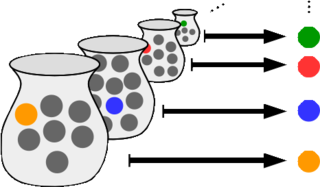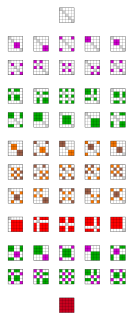
In mathematics, the axiom of choice, or AC, is an axiom of set theory equivalent to the statement that the Cartesian product of a collection of non-empty sets is non-empty. Informally put, the axiom of choice says that given any collection of bins, each containing at least one object, it is possible to make a selection of exactly one object from each bin, even if the collection is infinite. Formally, it states that for every indexed family of nonempty sets there exists an indexed family of elements such that for every . The axiom of choice was formulated in 1904 by Ernst Zermelo in order to formalize his proof of the well-ordering theorem.

In mathematics, an equivalence relation is a binary relation that is reflexive, symmetric and transitive. The relation "is equal to" is the canonical example of an equivalence relation, where for any objects a, b, and c:

Functional analysis is a branch of mathematical analysis, the core of which is formed by the study of vector spaces endowed with some kind of limit-related structure and the linear functions defined on these spaces and respecting these structures in a suitable sense. The historical roots of functional analysis lie in the study of spaces of functions and the formulation of properties of transformations of functions such as the Fourier transform as transformations defining continuous, unitary etc. operators between function spaces. This point of view turned out to be particularly useful for the study of differential and integral equations.

In mathematical analysis, the intermediate value theorem states that if f is a continuous function whose domain is the interval [a, b], then it takes on any value between f(a) and f(b) at some point within the interval.
In complex analysis, the Riemann mapping theorem states that if U is a non-empty simply connected open subset of the complex number plane C which is not all of C, then there exists a biholomorphic mapping f from U onto the open unit disk

In mathematics, a theorem is a statement that has been proven on the basis of previously established statements, such as other theorems, and generally accepted statements, such as axioms. A theorem is a logical consequence of the axioms. The proof of a mathematical theorem is a logical argument for the theorem statement given in accord with the rules of a deductive system. The proof of a theorem is often interpreted as justification of the truth of the theorem statement. In light of the requirement that theorems be proved, the concept of a theorem is fundamentally deductive, in contrast to the notion of a scientific law, which is experimental.

In mathematics, a conformal map is a function that preserves orientation and angles locally. In the most common case, the function has a domain and an image in the complex plane.

In mathematics, mathematical physics and the theory of stochastic processes, a harmonic function is a twice continuously differentiable function f : U → R where U is an open subset of Rn that satisfies Laplace's equation, that is,
In social choice theory, Arrow's impossibility theorem, the general possibility theorem or Arrow's paradox is an impossibility theorem stating that when voters have three or more distinct alternatives (options), no ranked voting electoral system can convert the ranked preferences of individuals into a community-wide ranking while also meeting a specified set of criteria: unrestricted domain, non-dictatorship, Pareto efficiency, and independence of irrelevant alternatives. The theorem is often cited in discussions of voting theory as it is further interpreted by the Gibbard–Satterthwaite theorem. The theorem is named after economist and Nobel laureate Kenneth Arrow, who demonstrated the theorem in his doctoral thesis and popularized it in his 1951 book Social Choice and Individual Values. The original paper was titled "A Difficulty in the Concept of Social Welfare".

In mathematics, particularly in complex analysis, a Riemann surface is a one-dimensional complex manifold. These surfaces were first studied by and are named after Bernhard Riemann. Riemann surfaces can be thought of as deformed versions of the complex plane: locally near every point they look like patches of the complex plane, but the global topology can be quite different. For example, they can look like a sphere or a torus or several sheets glued together.
In the mathematical areas of order and lattice theory, the Knaster–Tarski theorem, named after Bronisław Knaster and Alfred Tarski, states the following:
In mathematics, the uniform boundedness principle or Banach–Steinhaus theorem is one of the fundamental results in functional analysis. Together with the Hahn–Banach theorem and the open mapping theorem, it is considered one of the cornerstones of the field. In its basic form, it asserts that for a family of continuous linear operators whose domain is a Banach space, pointwise boundedness is equivalent to uniform boundedness in operator norm.
In mathematics, specifically differential calculus, the inverse function theorem gives a sufficient condition for a function to be invertible in a neighborhood of a point in its domain: namely, that its derivative is continuous and non-zero at the point. The theorem also gives a formula for the derivative of the inverse function. In multivariable calculus, this theorem can be generalized to any continuously differentiable, vector-valued function whose Jacobian determinant is nonzero at a point in its domain, giving a formula for the Jacobian matrix of the inverse. There are also versions of the inverse function theorem for complex holomorphic functions, for differentiable maps between manifolds, for differentiable functions between Banach spaces, and so forth.
In mathematical analysis, a family of functions is equicontinuous if all the functions are continuous and they have equal variation over a given neighbourhood, in a precise sense described herein. In particular, the concept applies to countable families, and thus sequences of functions.

In mathematics, the homotopy principle is a very general way to solve partial differential equations (PDEs), and more generally partial differential relations (PDRs). The h-principle is good for underdetermined PDEs or PDRs, such as occur in the immersion problem, isometric immersion problem, fluid dynamics, and other areas.
In the foundations of mathematics, von Neumann–Bernays–Gödel set theory (NBG) is an axiomatic set theory that is a conservative extension of Zermelo–Fraenkel set theory (ZFC). NBG introduces the notion of class, which is a collection of sets defined by a formula whose quantifiers range only over sets. NBG can define classes that are larger than sets, such as the class of all sets and the class of all ordinals. Morse–Kelley set theory (MK) allows classes to be defined by formulas whose quantifiers range over classes. NBG is finitely axiomatizable, while ZFC and MK are not.
In mathematics, algebraic geometry and analytic geometry are two closely related subjects. While algebraic geometry studies algebraic varieties, analytic geometry deals with complex manifolds and the more general analytic spaces defined locally by the vanishing of analytic functions of several complex variables. The deep relation between these subjects has numerous applications in which algebraic techniques are applied to analytic spaces and analytic techniques to algebraic varieties.

In mathematics, an Euclidean group is the group of (Euclidean) isometries of an Euclidean space 𝔼n; that is, the transformations of that space that preserve the Euclidean distance between any two points. The group depends only on the dimension n of the space, and is commonly denoted E(n) or ISO(n).
In the mathematical field of analysis, quasiregular maps are a class of continuous maps between Euclidean spaces Rn of the same dimension or, more generally, between Riemannian manifolds of the same dimension, which share some of the basic properties with holomorphic functions of one complex variable.










